Chapter 3 Powering the System On and Off
This chapter contains information about powering the system on and off, reading boot messages, and interpreting system status by viewing the LEDs.
Using JumpStart Automatic Installation
The Sun Enterprise 6500/5500/4500 systems can use the JumpStart(TM) automatic installation feature that is described in installation documents for Solaris software. The software that enables this feature is present on a hard disk in your system if the system was built at the factory with internal disk boards or disk trays.
JumpStart will run only when the system is powered on for the first time.
JumpStart may incorrectly install the system as a standalone workstation. You should prevent JumpStart automatic installation from proceeding if the appropriate server-specific configuration information is not in place. Information about the JumpStart feature is on a card titled "JumpStart Installation Instructions" that is provided with the system documentation.
To prevent JumpStart installation from occurring unintentionally:
-
Do not connect the system to a network when you power it on initially.
-
Do not place a Solaris release CD-ROM in a drive when you first power on the machine.
Note -
If JumpStart automatic installation begins unintentionally, interrupt it by pressing L1-A (Stop-A) or Break (on TTYa). Perform a manual installation when you are ready.
If JumpStart completes the installation incorrectly, you may need to reinstall Solaris 2.x manually.
Enterprise 6500/5500 Cabinet Systems
Powering On the System
Note -
It is advisable to connect an ASCII terminal to the system during installation. See "Connecting an ASCII Terminal", for terminal settings and connections. Observe the yellow (middle) LED on the front panel. It should go off when the boot process completes. If it remains lit, observe the terminal screen for boot messages produced by the firmware diagnostic program during power on.
To power on the cabinet system:
-
Begin with a safety inspection of the system:
-
Turn the system key switch to
 (the Standby position).
(the Standby position).See Figure 3-1.
Note -The standby position (
 ) does not turn off any AC-powered drive trays in the lower part of the system cabinet. The key switch controls only the DC power supply and DC-powered devices in the main cabinet.
) does not turn off any AC-powered drive trays in the lower part of the system cabinet. The key switch controls only the DC power supply and DC-powered devices in the main cabinet.
-
Turn the AC power sequencer power switch (Figure 3-2) to Off.
The AC power sequencer is at the rear of the cabinet.
-
Verify that the cabinet AC power cord is plugged into a wall socket.
Figure 3-1 Key Switch on the Enterprise 6500/5500
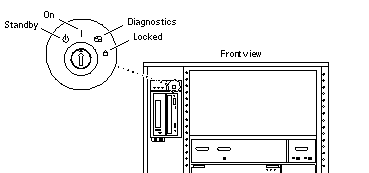 Table 3-1 Key Switch Positions
Table 3-1 Key Switch PositionsPosition
Function
Standby
Off, no DC power
On
Normal power on
Diagnostics
Normal power on, with full diagnostics
Locked
Normal power on, in secure mode
 Caution -
Caution - The outlet must be a 200-240 VAC 30A circuit intended solely for use by the server cabinet. The electrical receptacles must be grounded, and the grounding conductors serving these receptacles must be connected to the earth ground at the service equipment.
 Caution -
Caution - Do not disconnect the AC power cord from the wall socket when you work on or in the server cabinet. This connection provides a ground path that prevents damage from electrostatic discharge.
 Caution -
Caution - Never move the system or expansion cabinets when system power is on. Excessive movement can cause catastrophic disk drive failure. Always power the system OFF before moving it.
-
-
Turn on power to any expansion cabinets.
Read the documentation supplied with each type of expansion cabinet for specific instructions.
Figure 3-2 Switches on the AC Power Sequencer
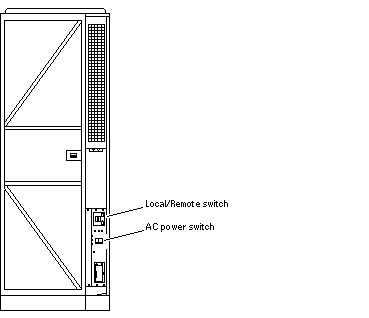
-
Turn on power to the terminal (if applicable).
-
Set the system cabinet Local/Remote switch (Figure 3-2) to Local.
-
Turn the AC power switch (Figure 3-2) to On.
Listen for the sound of AC-powered devices such as disk drives and fans in the disk drive tray(s).
Note -The front panel keys for this switch are packed in the accessory box.
-
Turn the key switch to the On position.
The system will run firmware diagnostics for about one minute and then boot.
You should see and hear several things happen:
-
The fans in the power supplies begin turning.
-
The left LED (green) on the front of the cabinet turns on immediately to indicate the DC power supply is functioning.
-
The middle LED (yellow) begins flashing.
-
The right LED (green) flashes after firmware completes to denote that the operating system is running.
-
The terminal screen lights up upon completion of the internal self-test.
-
-
Watch the terminal screen for any firmware error messages.
Note -If the middle front panel LED remains lit after the system has booted, firmware has found (and deconfigured) failing hardware in the main cabinet.
POST (power-on-self-test) tests subassemblies and some interface paths between subassemblies.
At the conclusion of testing, firmware automatically attempts to reconfigure the system, omitting any parts of the system that have failed diagnostics.
If there are no faults, or if firmware completes a successful reconfiguration in response to detected faults, the system boots.
If the system is unable to communicate with the network, see "Failure of Network Communications".
Note -POST does not test drives or internal parts of SBus cards. To test these devices, run OpenBoot PROM (OBP) diagnostics manually after the system has booted. Refer to the OpenBoot Command Reference for instructions.
Note -If faulty parts are detected and configured out of the working system, you and the system manager must decide whether to operate the system until replacement parts arrive, or to halt operation. Also, if a faulty component cannot be replaced in the field, the entire subassembly (like the system board) must be replaced.
-
To restart firmware, or if the system hangs, press the CPU reset switch on the clock+ board (Figure 3-3).
Figure 3-3 Reset Switches on the Clock+ Board
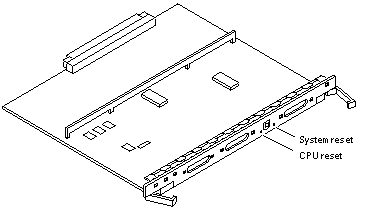
Reading Boot Messages
Use the boot software messages to verify that all options are installed and recognized by the system. After firmware completes the system self-test, a message similar to the following will appear on your screen. The message lists hardware detected in the system.
Note -
This screen display is an example only. The actual message displayed on the screen will vary with the software running on the system.
16-slot Sun Enterprise 6500, Keyboard Present OpenBoot -.- FCS, --- MB memory installed, Serial #---. Ethernet address -:-:--:-:--:--, Host ID: ------.
If firmware indicates a hardware problem at this time, refer to troubleshooting section in the Sun Enterprise 6500/5500/4500 Systems Reference Manual for further instructions.
Note -
When the system finishes booting for the first time -- if there is no appropriate server configuration file on the disk drive -- it may be necessary to prevent the JumpStart automatic configuration program from running. See the caution in "Using JumpStart Automatic Installation".
Interpreting Status LED Patterns
If there is no terminal on the system, basic system status information is available on the front panel LEDs, as shown in Figure 3-4.
Figure 3-4 System Status LEDs (Cabinet Server)
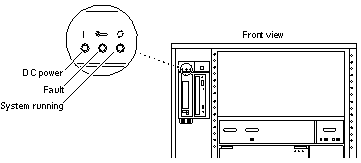
Table 3-2 summarizes LED status indications.
Table 3-2 Front Panel LED Status Indicators|
LED Position |
Condition |
|---|---|
|
Left LED (green) |
On -- DC power supply is receiving AC current. Off -- There is no DC power. |
|
Middle LED (yellow) |
On Flashing -- (first 60 seconds) self-tests are running. Off -- (after self-tests end) No hardware failures. On -- (after self-tests end) Hardware failure was detected. |
|
Right LED (green) |
Off -- (first 60 seconds) self-tests are running. On Flashing -- (after self-tests end) System is running. Off -- (after self-tests end) System cannot run; repair is needed. |
Powering Off the System
Before turning off the system power, you must halt the operating system. See the Preface, "UNIX Commands, to find references if you need help with the commands for this task or other system administration procedures.
Note -
Failure to halt the operating system properly can cause the loss of disk drive data.
Note -
Do not disconnect the terminal while the system is running.
To avoid damaging internal circuits, do not disconnect or connect any cable while power is applied to the system.
To shut down the system:
-
Notify users that the system is going down.
-
Back up the system files and data to tape, if necessary.
-
Halt the system using the appropriate commands. Refer to the Solaris Handbook for SMCC Peripherals that corresponds to your operating system.
-
Wait for the system-halted message and the boot monitor prompt.
-
Turn the key switch on the front panel of the server to the Standby position (fully counterclockwise).
-
Turn off the system power in this order:
-
External drives and expansion cabinets (if any)
-
System cabinet AC power switch
-
Terminal
For more system administration information on methods for shut-down and backup, see the Preface, "UNIX Commands, for references to documentation that describes these procedures.
Enterprise 4500 System
Powering On the System
Note -
It is advisable to connect an ASCII terminal to the system during installation. See "Connecting an ASCII Terminal", for terminal settings and connections. Observe the yellow (middle) LED on the front panel. It should go off when the boot process completes. If it remains on, observe the terminal screen for boot messages produced by the firmware diagnostic program during power-on.
To power on the Enterprise 4500 system:
-
Begin with a safety inspection of the system.
-
Turn the system key switch (Figure 3-5) to
 (the Standby position).
(the Standby position). -
Turn the AC power switch (Figure 3-6) to Off.
-
Verify that the AC power cord is plugged into a wall socket.
 Caution -
Caution - Do not disconnect the power cord from the wall socket when working on the server. This connection provides a ground path that prevents damage from uncontrolled electrostatic discharge.
-
-
Turn on power to any expansion cabinets.
Read the documentation supplied with each type of expansion cabinet for specific instructions.
-
Turn on the terminal (if applicable).
Figure 3-5 Key Switch on the Enterprise 4500
 Table 3-3 Key Switch Positions
Table 3-3 Key Switch PositionsPosition
Function
Standby
Off, no DC power
On
Normal power on
Diagnostics
Normal power on, with full diagnostics
Locked
Normal power on, in secure mode
-
At the rear of the Enterprise 4500 cabinet, turn the AC power switch to On.
-
Turn the key switch (Figure 3-6) to the On position.
You should see and hear several things happen:
-
The fans in the power supplies begin turning.
-
The top front panel LED (green) turns on immediately denoting the power supply is delivering DC power.
-
The middle front panel LED (yellow) flashes while POST runs for approximately 60 seconds. After 60 seconds, this LED turns off if the tests pass. If the LED remains lighted after 60 seconds, a test has failed.
-
The bottom front panel LED (green) flashes to show that booting is successful and the operating system is running. If this LED fails to turn on and the middle LED is on, a severe hardware fault exists.
Figure 3-6 AC Power Switch on the Enterprise 4500
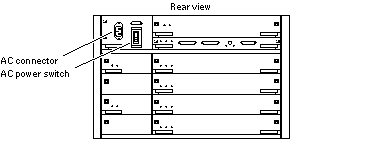
 Caution -
Caution - Never move the system when the power is on. Failure to heed this warning may result in catastrophic disk drive failure. Always power the system off before moving it.
-
-
Watch the terminal screen for error messages.
POST (power-on-self-test) tests subassemblies and some interface paths between subassemblies.
At the conclusion of testing, firmware automatically attempts to reconfigure the system, omitting any parts of the system that have failed diagnostics.
If there are no faults, or if firmware completes a successful reconfiguration in response to detected faults, the system boots.
Note -If faulty parts are detected and configured out of the working system, you and the system manager must decide whether to operate the system until replacement parts arrive, or to halt operation. Also, if a faulty component cannot be replaced in the field, the entire subassembly (like the system board) must be replaced.
-
To restart firmware, or if the system hangs, press the CPU reset switch (Figure 3-7) on the clock+ board.
Figure 3-7 Reset Switches on the Clock+ Board

Reading Boot Messages
Use the boot software messages to verify that all options are installed and recognized by the system. After firmware completes the system self-test, a message similar to the following will appear on your screen. The message lists hardware detected in the system.
Note -
The following screen display is an example only. The actual message displayed on the screen will depend on the software running on your system.
8-slot Sun Enterprise 5500/4500, Keyboard Present OpenBoot -.- FCS, --- MB memory installed, Serial #---. Ethernet address -:-:--:-:--:--, Host ID: ------.
If firmware indicates a hardware problem at this time, refer to the Sun Enterprise 6500/5500/4500 Systems Reference Manual, Part 3, "Troubleshooting, for further instructions.
Boot the system using the procedure that is appropriate for your operating system. See the Preface section "UNIX Commands" for a reference to documentation that describes this procedure.
Interpreting Status LED Patterns
If there is no terminal on the system, examine the front panel LEDs (Figure 3-8) for the status of the system (Table 3-4).
Figure 3-8 System Status LEDs (Standalone Server)
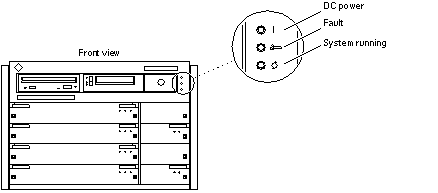 Table 3-4 Front Panel LED Status Indicators
Table 3-4 Front Panel LED Status Indicators|
LED Position |
Condition |
|---|---|
|
Left LED (green) |
On -- DC power supply is receiving AC current. Off -- There is no DC power. |
|
Middle LED (yellow) |
On Flashing -- (first 60 seconds) self-tests are running. Off -- (after self-tests end) No hardware failures. On -- (after self-tests end) Hardware failure was detected. |
|
Right LED (green) |
Off -- (first 60 seconds) self-tests are running. On Flashing -- (after self-tests end) System is running. Off -- (after self-tests end) System cannot run; repair is needed. |
When the self-test completes, both top and bottom LEDs should be on. If the system runs but needs service, all three LEDs will be on. If the system cannot boot, the top and middle LEDs will be on. In a complete failure, none of the LEDs will light.
Powering Off the System
Before turning off the system power, you must halt the operating system. See the Preface section "UNIX Commands" to find references if you need help with the commands for this task or other system administration procedures.
Note -
Failure to halt the operating system properly can cause the loss of disk drive data.
Note -
Do not disconnect the terminal while the system is running.
To avoid damaging internal circuits, do not disconnect or plug in any cable while power is applied to the system.
To shut down the system:
-
Notify users that the system is going down.
-
Back up the system files and data to tape, if necessary.
-
Halt the system using the appropriate commands. Refer to the Solaris Handbook for SMCC Peripherals that corresponds to your operating system.
-
Wait for the system-halted message and the boot monitor prompt.
-
Turn the key switch on the front panel of the server to the Standby position (fully counterclockwise).
-
Turn off the system power in this order:
-
External drives and expansion cabinets (if any)
-
System AC power switch
-
Terminal
-
For more system administration information on methods for shut-down and backup, see the Preface section "UNIX Commands" for references to documentation that describes these procedures.
Failure of Network Communications
Description of the Problem
The system cannot communicate with a network if the system and the network hub are not set in the same way for the Ethernet link integrity test. This problem particularly applies to 10BASE-T network hubs, where the Ethernet link integrity test is optional. This is not a problem for 100BASE-T networks, where the test is enabled by default.
If you connect the system to a network and the network does not respond, use the OpenBoot command watch-net-all to display conditions for all network connections:
ok watch-net-all
For SBus Ethernet cards, the test can be enabled or disabled with a hardware jumper, which you must set manually. For the TPE and MII onboard ports on the I/O+ board, the link test is enabled or disabled through software, as shown below.
Remember also that the TPE and MII ports are not independent circuits and as a result, both ports cannot be used at the same time.
Note -
Some hub designs do not use a software command to enable/disable the test, but instead permanently enable (or disable) the test through a hardware jumper. Refer to the hub installation or user manual for details of how the test is implemented.
Determining the Device Names of the I/O+ Boards
To enable or disable the link test for an onboard TPE (hme) port, you must first know the device name for the I/O+ board. To list the device names:
-
Shut down the system and take the system into OpenBoot.
-
Determine the device names of the I/O+ boards:
Solution 1
Use this method while the operating system is running:
-
Become superuser.
-
# eeprom nvramrc="probe-all install-console banner apply disable-link-pulse \ device-name " (Repeat for any additional device names.) # eeprom "use-nvramrc?"=true
-
Reboot the system (when convenient) to make the changes effective.
Solution 2
Use this alternate method when the system is already in OpenBoot:
- © 2010, Oracle Corporation and/or its affiliates
